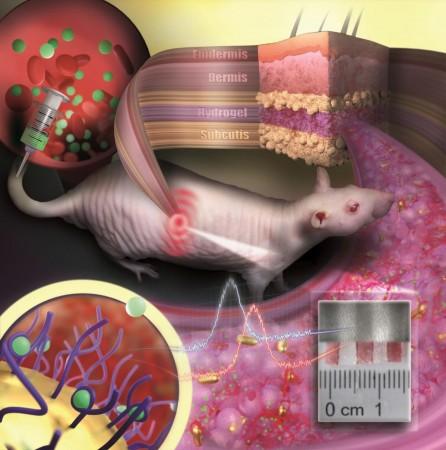Flaunting gold on one's body can be indicative of their wealth. However, according to a new study, nanoparticles of the precious metal inside the body can inform about one's health as well. Scientists from the Johannes Gutenberg University Mainz (JGU) have developed an 'invisible tattoo' made of gold nanoparticles that can help in better medical diagnosis.
The 'tattoo' is a sensor that consists of a synthetic tissue that has been embedded with gold nanoparticles—that are invisible to the naked eye—and is implanted under the skin. Being color-sensitive, the gold particles change color when there are variations in drug concentrations within the body.
Talking about the revolutionary diagnostic device, Prof. Carsten Sönnichsen, corresponding author of the study, said in a statement, "Our sensor is like an invisible tattoo, not much bigger than a penny and thinner than one millimeter."
Need for an Ideal Diagnostic Tool

The concept of an implantable sensor that can continually monitor and report the concentration of drugs or chemicals in the body and other vitals is the ultimate diagnostic holy grail. While such sensors do exist, they are bound by restrictions that make them unviable for long-term use. Firstly, they require continuous replacement due to their progressive degeneration. This makes them impractical for permanent use.
Secondly, the probability of the body rejecting such sensors is high. The challenge arises as the body can identify a sensor as a foreign material or object and reject it. Therefore, an ideal implantable sensor is one that is readily accepted by the body and does not require constant replacement; the new sensor meets both the requirements.
New Age Implantable Sensor
Utilizing gold nanoparticles as sensors, the team has been studying their ability to detect minuscule quantities of proteins in microscopic flow cells for several years. Gold nanoparticles have the ability to scatter light after absorbing it, thereby, appearing colorful. They also change color in response to modifications that their surroundings undergo. It is this unique property that the scientists leveraged for the making of a sensor for medical use.
For the current study, the authors embedded gold nanoparticles into a porous hydrogel whose consistency is similar to real tissue. This protects the particles from degradation caused by immune cells and also prevents them from drifting away. Minute cells and blood vessels begin growing within the pores of the sensor after being implanted beneath the skin. Therefore, the integration with tissues prevents the sensor's rejection as a foreign material.

Being infrared in nature, the gold nanoparticles are invisible to the naked eye. Nonetheless, they can be detected using a specialized noninvasive device. In order to ascertain the efficacy of the sensor, the team tested the device on rodents.
Revolutionary Potential
The gold nanoparticle sensors were implanted beneath the skin of hairless rats. For the purpose of examining the change in color, an antibiotic was administered to the rats in different doses. As the drug molecules spread across their bodies, they reached the sensor through the bloodstream. The antibiotic particles bound to particular receptors found on the surface of the nanoparticles. This induced changes in color depending on the concentration of the drug. Most importantly, the sensors were found to retain their optical and mechanical stability for several months.
Dr. Katharina Kaefer, first author of the study, explained, "We are used to colored objects bleaching over time. Gold nanoparticles, however, do not bleach but keep their color permanently. As they can be easily coated with various different receptors, they are an ideal platform for implantable sensors."
Due to its flexible applicability, the novel concept may help revolutionize several areas in the future. "Because of the easy adaptability of gold nanoparticles toward different analytes, our concept will find versatile applications in personalized medicine or pharmaceutical development," wrote the authors. It can also aid in the observation of drugs or biomarkers within the body, whose varying concentrations can be indicative of illnesses.

















